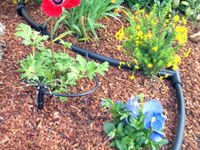As a water conservationist, I always recommend drip irrigation to my clients. Aside from conserving water consumption, a drip irrigation system has many other benefits. It saves you money on your water bill and we all like to hear that! But it also helps to prevent disease because it minimizes the water contact with plant leaves, stems and fruits.
Here’s a little more about it. Drip irrigation, also know as trickle irrigation, was first employed about 40 years ago in Israel to maximize the scarcity of water. Drip irrigation has an efficiency of 90 percent compared to 50 percent to 70 percent with typical sprinkler systems. Because it is so efficient, during times of drought it may be exempt from watering restrictions. Much of the water applied with a sprinkler system is lost to evaporation and never used by the plants.
When an area is watered it gradually seeps down to the root zone. Each layer of soil must reach its saturation point before the next layer receives the water. If a gardener applies only half the amount required, the water will only saturate the top part of the root zone and the rest remains dry. Once the soil is wet, the plant’s roots can then begin to absorb the water and move it through the plant. Drip irrigation delivers a low volume of water directly to the plant’s root zone.
The setup should be designed around the watering requirements of the plant and the size of the plant. Most landscape designs have different plants in the landscape. Each plant is given its own emitter nozzle determined by the type of plant. The use of flood tubing or soaker hose is not recommended for new plants or trees. Soaker hose or flood tubing is fine for established hedgerows where the plants are established. Even new drought tolerant plants still need water when first planted at least for 2 seasons, however you do not want to overwater by placing an emitter that puts out too much water.
Water pressure in most homes ranges from 20 to 60 pounds per square inch. Lowering the pressure for a drip system is accomplished with a pressure regulator. Before the water enters the drip hose from a general hose you will need a filter to remove sand and debris. A backflow prevention device and a control valve are also necessary.
Plus drip irrigation also saves you time in your garden! The system allows the rows between plants to remain dry decreasing the weed growth minimizing the amount of time spent watering and weeding!

